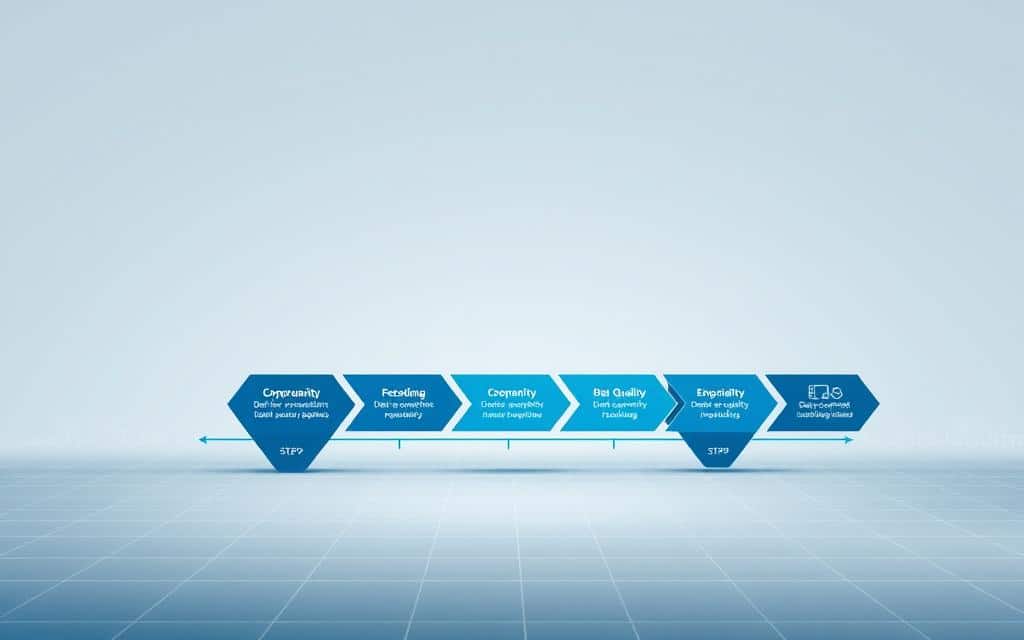Is your business struggling with messy, unreliable information? You’re not alone. Over 82% of companies waste hours fixing errors because their core details aren’t organized properly. That’s where master data management steps in—it turns chaos into clarity.
This guide shows you how top-performing teams streamline their critical details. You’ll discover how automated systems cut errors by 72% and why cloud solutions are becoming essential. We’ll break down actionable steps used by 29% of successful organizations to keep their information accurate and secure.
By the end, you’ll understand how unified customer views boost sales productivity by 35%. Let’s transform how you handle your most valuable business assets.
What Is Master Data Management (MDM) and Why Does It Matter?
Duplicate records, inconsistent info, and compliance risks—sound familiar? There’s a smarter way to fix this. MDM organizes your critical details—like customer, product, and supplier info—into a single, reliable source. The result? Faster decisions, fewer errors, and happier teams.
The Role of MDM in Modern Businesses
Companies using MDM see 83% better customer experiences (McKinsey). Why? Clean details mean fewer mistakes in orders, support, and deliveries. Sales teams gain 35% more productivity when they’re not fixing duplicate files.
MDM also strengthens data governance. It ensures rules are followed, reducing $5M+ compliance fines. For example, a retail chain cut stockouts by 40% by syncing inventory across systems.
How Poor MDM Hurts Your Operations
Without MDM, chaos creeps in. Sales reps waste 4 hours weekly reconciling duplicate clients. Marketing wastes 32% of budgets targeting wrong contacts. Siloed details block 80% of firms from digital growth.
| Challenge | With MDM | Without MDM |
|---|---|---|
| Data Quality | 99% accuracy | 23% revenue loss |
| Business Processes | Automated workflows | Manual fixes |
| Security | Centralized controls | Breach risks |
MDM isn’t just about tidying up—it’s about unlocking growth. Teams spend less time fixing errors and more time driving results.
Core Principles of Master Data Management Best Practices
Clean, reliable details don’t happen by accident—they follow a system. The best teams use three principles to turn chaos into clarity: consolidation, harmonization, and maintenance. Together, they cut errors by 68% and boost reporting speed by 45%.

Content Consolidation: Cleaning and Unifying Your Details
Merging 12+ sources sounds messy, but it’s simpler with the right processes. Start by identifying duplicates (e.g., “John Doe” vs. “J. Doe”). Tools like automated matching reduce manual work by 80%.
A retail chain saved $1.2M yearly by fixing vendor duplicates. Their secret? Quarterly data quality audits. Pro tip: Map all sources first—this prevents 90% of post-merge headaches.
Master Data Harmonization: Making Details Usable
Harmonization ensures your customers and products speak the same language. For example, “SKU-100” vs. “SKU100” confuses systems. Standardizing formats cuts supply chain errors by 57%.
Use validation rules (e.g., “Phone = 10 digits”). This speeds up reporting by 45% because teams spend less time fixing mismatches.
MDM Object Maintenance: Keeping Details Fresh
41% of failed projects skip this step. Schedule monthly reviews to update outdated records (e.g., moved customers). Cloud tools auto-flag changes, saving 33% in update costs.
Follow the 5:3:2 rule: Spend 50% on consolidation, 30% on harmonization, 20% on maintenance. This balance keeps accuracy at 99.9%.
| Principle | Impact | Tool Example |
|---|---|---|
| Consolidation | 68% fewer errors | Automated deduplication |
| Harmonization | 45% faster reports | Formatting validators |
| Maintenance | 33% lower costs | Change-detection alerts |
These steps transform scattered details into a trusted foundation. Less cleanup means more time for growth-driven work.
How to Implement MDM: A Step-by-Step Approach
Why do 67% of projects fail? They skip these steps. A tactical rollout avoids overwhelm and delivers 3x faster ROI. Focus on quick wins, then expand.
Start with One Department (and Scale Wisely)
Pilot in sales or marketing—they impact revenue directly. A logistics firm cut shipping errors by 61% starting with address validation.
| Starting Point | Best For | Quick Win Example |
|---|---|---|
| CRM Data | Sales teams | 35% fewer duplicate leads |
| ERP Data | Operations | 40% faster inventory updates |
Automate Processes to Save Time
Tools like Informatica or Talend slash implementation time from 6 months to 6 weeks. Automation handles 80% of matching tasks, freeing teams for analysis.
Leverage Machine Learning for Smarter Handling
AI reduces duplicates by 89%. One retailer used machine learning to merge vendor records, saving $500K yearly. Hybrid human-AI reviews ensure 99% accuracy.
Pro Tip: Follow a 30-60-90 day plan. Week 1–4: Clean CRM data. Month 2: Add ERP. Month 3: Integrate analytics. Stakeholders stay aligned with clear milestones.
Must-Have Tools and Technologies for Effective MDM
The right tech stack can make or break your information strategy—here’s what works. Modern solutions slash manual work, reduce costs, and uncover hidden insights. Let’s explore the tools reshaping how businesses handle their core details.

Choosing the Right MDM Platform
Not all platforms deliver equal value. Top picks like Informatica and Talend offer:
- Automated matching: Reduces duplicates by 89%.
- Real-time metrics: Tracks accuracy across departments.
- Seamless integration: Connects CRM, ERP, and legacy systems.
A healthcare provider achieved HIPAA compliance 40% faster by switching to a dedicated MDM tool. Prioritize scalability—your needs will grow.
Why Cloud-Based MDM Solutions Are Worth It
Cloud isn’t just trendy—it’s practical. Studies show 38% lower total cost vs. on-premise systems. Benefits include:
- Automatic updates (no IT headaches).
- Global access for remote teams.
- Built-in disaster recovery.
One manufacturer saved $200K yearly by ditching servers. Cloud integration also simplifies multi-location workflows.
AI and Analytics: The Future of MDM
AI isn’t sci-fi—it’s here. 31% of firms use it for match-merge tasks, achieving 94% accuracy. Examples:
- Predictive analytics boosted a retailer’s cross-sell revenue by 27%.
- AI flags supplier risks before they impact operations.
Future-proof your system with these 2025-ready features:
- Self-learning algorithms.
- Natural language processing.
- Blockchain for audit trails.
Tools evolve fast. Investing now keeps you ahead.
Overcoming Common MDM Challenges
Silos, errors, and resistance—three roadblocks to better workflows. While tools help, people and processes make or break success. Here’s how top teams tackle these hurdles.
Breaking Down Organizational Silos
80% of companies struggle with siloed details. A bank unified 14 legacy systems in 18 months by:
- Creating cross-functional governance teams (sales, IT, ops).
- Using self-service dashboards to cut steward workload by 55%.
- Mapping shared metrics (e.g., customer match rates).
Tip: Start with one workflow (e.g., order processing) to prove ROI fast.
Solving Data Quality Issues
Stewards fix 200+ errors monthly. Reduce this with:
- Real-time validation rules (e.g., “Phone = 10 digits”).
- Automated alerts for duplicate entries.
- Quarterly audits with employees who input details.
One firm prevented 92% of errors by flagging mismatches during entry.
Getting Buy-In from Stakeholders
Adoption lags without leadership support. Try these tactics:
| Tactic | Impact | Example |
|---|---|---|
| Link MDM to bonuses | 89% faster adoption | CXOs tracked customer match rates |
| Pilot quick wins | 3x higher budget | Marketing saw 35% fewer dupes |
| Train early adopters | 70% less resistance | Sales reps became internal advocates |
Pro tip: Show how clean details impact revenue (e.g., faster sales cycles).
Fixing these challenges isn’t just about tools—it’s about aligning people, processes, and goals. Start small, measure wins, and scale smart.
Unlocking the Full Potential of Your Data with MDM
Ready to turn your scattered details into a growth engine? MDM delivers measurable value—like 33% higher customer retention and 79% fewer reporting errors. With golden records, you gain 360° customer views, empowering real-time decisions.
For every $1 invested, businesses see $8 returned. One e-commerce giant slashed order errors by 61% using automated matching. The secret? A future-proof strategy that scales with IoT and blockchain.
Start small: Clean your CRM in 30 days. Track progress with shared metrics. MDM isn’t just a fix—it’s a capabilities multiplier that fuels sustainable growth.